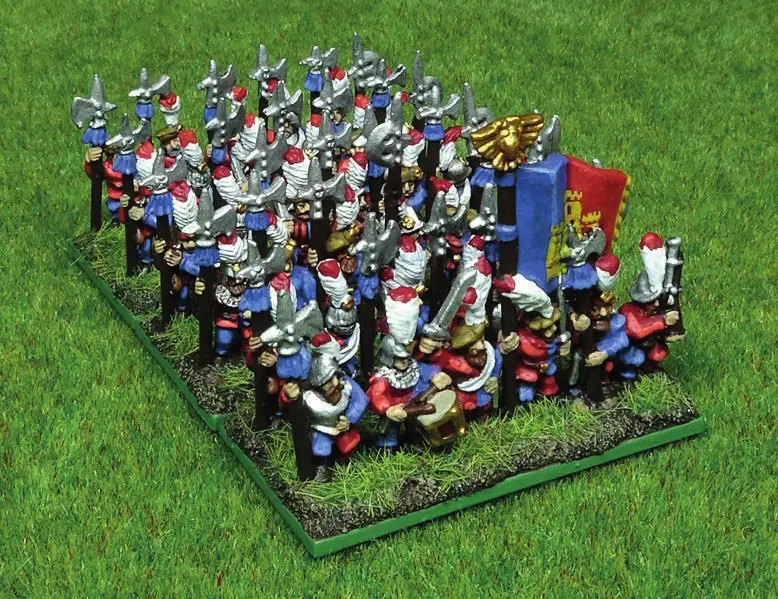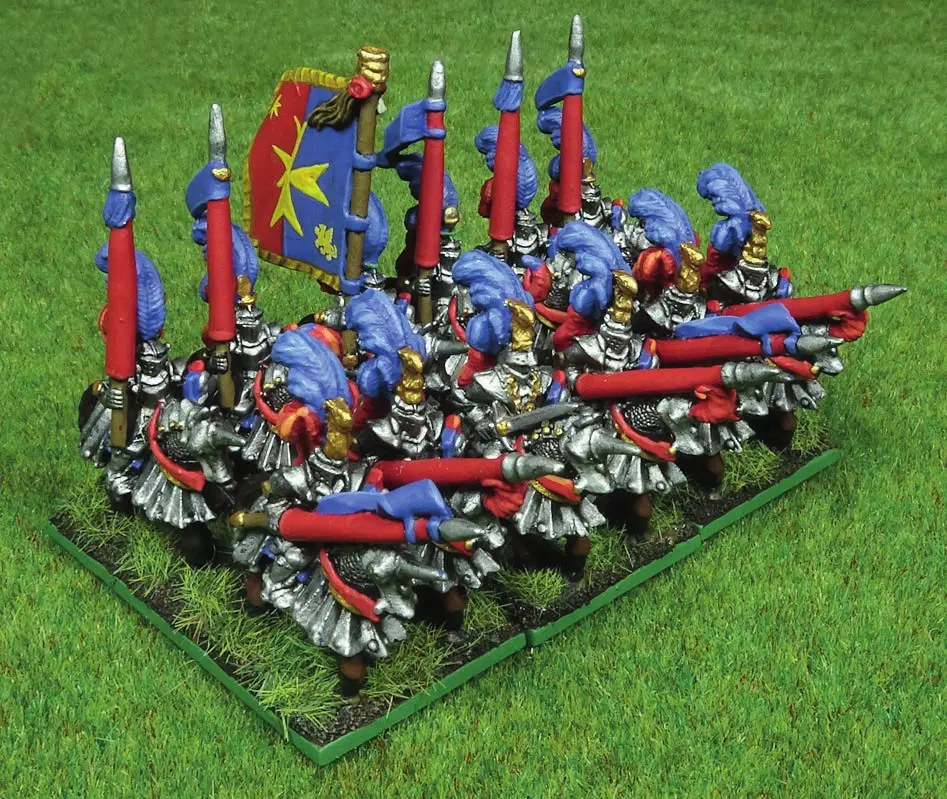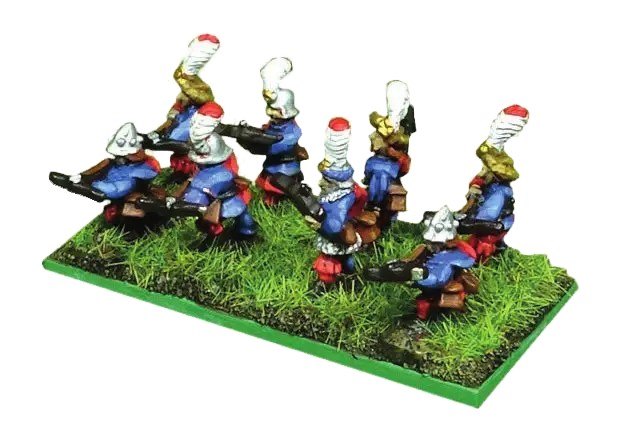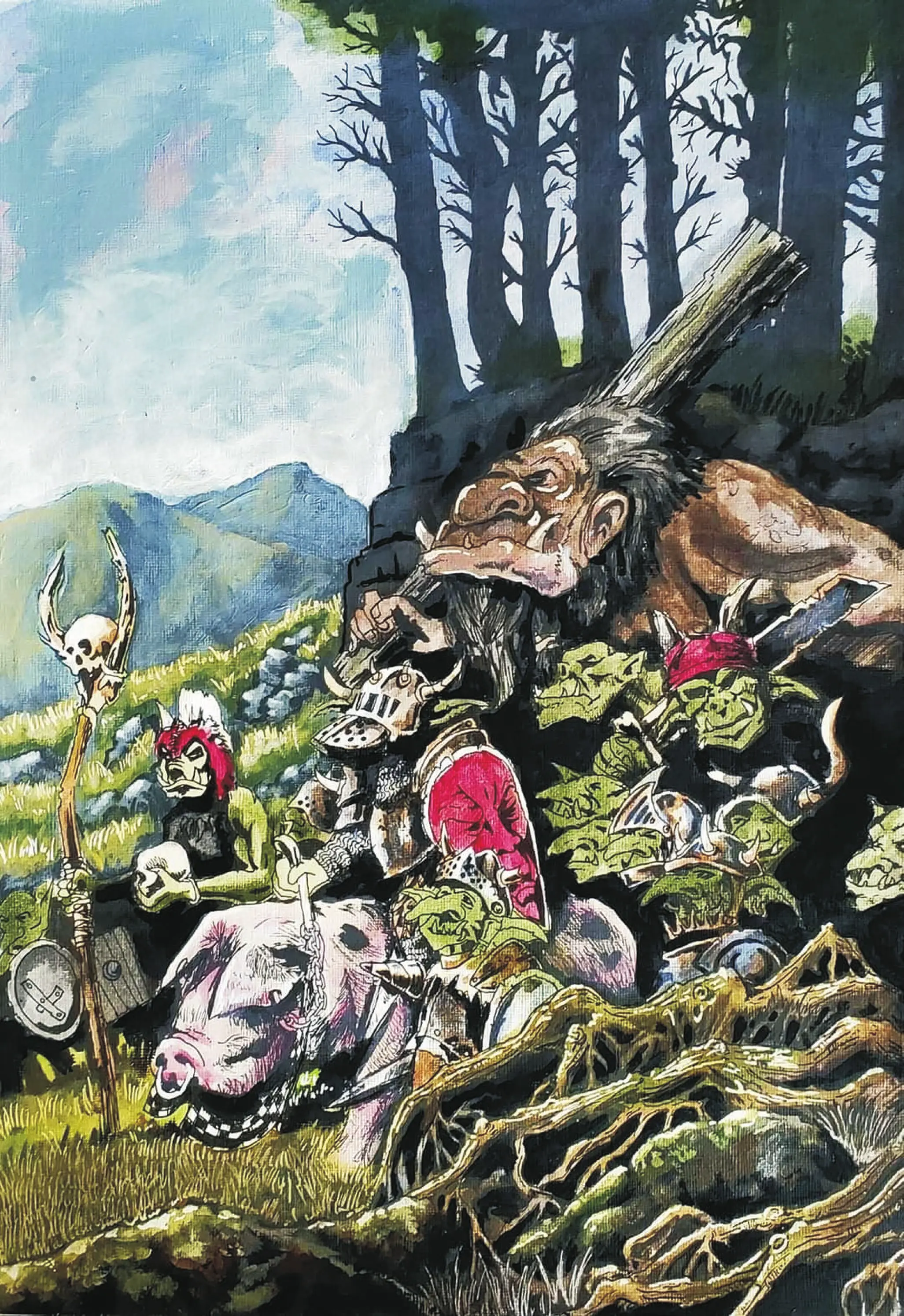Termes de Jeu
Avant de poursuivre les règles du jeu, nous allons catégoriser les différents types de troupes et définir en terme de jeu chacune d’elles.
Armées
Une partie de Warmaster se joue entre deux armées de figurines adverses. Chaque camp est contrôlé par un seul joueur qui planifie et exécute les mouvements de son armée et lance les dés nécessaires pour déterminer les résultats des mouvements et des combats.
Socles
Les pièces du jeu sont appelées socles. Il existe deux types de socles : les socles d’unité de 40 mm × 20 mm et les socles de personnage, souvent ronds et de 25 mm de diamètre afin de les distinguer facilement des socles de troupe. (Voir Socles de personnage de taille inhabituelle si vous avez des personnages sur des socles plus grands.)
Les figurines sont montées sur les socles afin de former des groupes représentatifs de troupes ou de personnages. Le nombre exact de figurines et leur positionnement relèvent du choix esthétique des joueurs.
Tous les socles d’unités ont des bords avant, latéraux et arrière, indiqués par l’orientation des figurines. Il est important que l’orientation du socle soit clairement visible, comme dans les exemples ci-dessous.
Unités
L’infanterie, la cavalerie et la plupart des autres types de troupes combattent en formations de plusieurs socles appelées unités. Plusieurs socles forment un régiment d’infanterie, un escadron de cavalerie, une batterie d’artillerie, etc. Tous les socles d’une même formation sont toujours disposés de manière à se toucher, soit côte à côte, soit l’un derrière l’autre, soit en se touchant en un seul point. On parle alors de formation.
Les unités se composent généralement de trois socles du même type, mais cela peut varier et parfois une unité peut ne comporter qu’un seul socle, comme nous le verrons plus tard.
Jusqu’à quatre unités peuvent être temporairement regroupées pour former une brigade. Nous aborderons les brigades plus en détail dans les règles suivantes.
Personnages
Outre les troupes décrites, les armées comprennent toujours un Général et peuvent également inclure d’autres Héros et Sorciers. Elles sont constituées d’un seul socle comprenant le puissant personnage ainsi que divers compagnons et serviteurs. Ces socles sont appelés personnages.
Infanterie, cavalerie, chars, monstres, artillerie et machines
D’une manière générale, les armées se composent d’infanterie, de cavalerie, de chars, de monstres, d’artillerie et de machines – cette dernière catégorie comprend divers engins étranges, comme nous le découvrirons.
Les règles distinguent ces six types de troupes. Les créatures monstrueuses de taille petite à moyenne sont généralement classées comme cavalerie ou infanterie. Les ogres, par exemple, font clairement partie de l’infanterie, bien que leur apparence n’en soit pas moins monstrueuse.

Les socles d’infanterie sont toujours orientés dans leur largeur, comme le montre l’unité Empire illustrée ci-dessus.

En règle générale, toutes les autres troupes, y compris les monstres et l’artillerie, ainsi que les chars, la cavalerie et les machines, sont orientées dans leur longueur, comme le montrent les unités illustrées à droite. Les exceptions sont indiquées dans la section « Listes d’armées ».
Attaques, points de vie et armure
Certaines troupes sont de meilleurs combattants que d’autres, certaines sont mieux entraînées, d’autres sont naturellement plus violentes, etc. Afin de représenter ces différentes qualités chez les guerriers, monstres et créatures étranges du jeu, nous attribuons trois valeurs à chaque socle : Attaques, Points de Vie et Armure.

| Attaques | Points de Vie | Armure |
|---|---|---|
3 |
3 |
6+ |
↙ |
↓ |
↘ |
Il s’agit du nombre de base de dés lancés au combat : plus il lance de dés, plus un socle est capable de causer des dégâts. |
C’est le nombre de dégâts qu’un socle peut encaisser avant d’être retiré du jeu. |
L’armure du socle représente la chance d’annuler les dégâts qui lui sont infligés. Une Armure de 6+ indique qu’un résultat de 6 est requis pour annuler un dégât, un 5+ qu’un 5 ou un 6 est requis et ainsi de suite. Une valeur de 0 signifie qu’un socle ne possède aucune armure. |
Attaques de tir
Les troupes disposant d’arcs ou d’autres armes de tir possèdent deux valeurs d’Attaques séparées par une barre, par exemple 3/1 ou 2/2. Dans ce cas, le premier nombre est toujours utilisé pour le corps à corps et le second pour le tir.

| Attaques | |
|---|---|
3/1 |
|
↙ |
↘ |
Valeur d’attaque au corps à corps |
Valeur d’attaque au tir |
Commandement
Le Commandement est une autre caractéristique essentielle ! Seuls certains personnages importants et votre Général en sont dotés pour pouvoir donner des ordres. Il varie de 7 à 10, mais seuls les meilleurs atteignent le niveau le plus élevé. Plus la valeur est élevée, plus vous avez de chances de pouvoir ordonner à vos troupes d’agir comme vous le souhaitez. Nous reparlerons du Commandement plus tard.
Valeur en points
Chaque unité et personnage du jeu se voit attribuer une valeur en points qui reflète sa valeur dans le jeu ; les unités et personnages les plus efficaces ont une valeur proportionnellement plus élevée. Une fois la bataille terminée, le total en points des pertes de chaque camp détermine la victoire. Autrement, la valeur des points n’a pas vraiment d’impact sur les règles du jeu.
Rien d’autre à savoir ?
La plupart des armées disposent de troupes particulières d’un type ou d’un autre, souvent dotées de règles spéciales pour refléter leurs capacités magiques ou extraordinaires. Vous n’avez pas besoin de les connaître pour le moment, alors ne vous en souciez pas. Plus tard, vous découvrirez que c’est ce qui différencie chaque armée et ce qui la rend intéressante et gratifiante à commander.
Visibilité sur le champ de bataille
Pendant la partie, les joueurs voudront que leurs unités tirent sur les ennemis, les chargent ou les esquivent. Dans ces cas, comme dans bien d’autres, il est important de savoir si les troupes peuvent voir l’ennemi et réagir efficacement et de manière cohérente.
Ce concept est à la base de nombreux aspects des règles du jeu ; nous allons donc l’expliquer ici avant toute autre chose. En tant que joueurs, nous pouvons facilement voir tout ce qui se passe sur le champ de bataille. Pour nos armées, la situation est bien différente. Il y a non seulement la question de la distance, mais aussi les subtiles élévations et creux du terrain, l’éblouissement du soleil de midi, la brume du petit matin, la lumière déclinante du crépuscule, la poussière soulevée par les armées rivales, etc. De ce fait, lorsque nous parlons d’unités qui voient d’autres unités, ou d’unités visibles, nous utilisons ces termes dans un sens spécifique. Lorsqu’on dit qu’une unité peut en « voir » une autre, on ne parle pas d’un ou deux guerriers qui peuvent théoriquement voir ; on veut dire que l’unité entière, y compris ses commandants, est positionnée pour observer et réagir de manière cohérente à la présence de l’ennemi.
Ligne de vue
Une unité peut en voir une autre s’il est possible de tracer une ligne de vue droite et ininterrompue entre le bord avant de l’un des socles de l’unité et une partie quelconque d’un socle de l’autre unité (voir Figure 3). Ce sont toujours les socles eux-mêmes qui sont pris en compte pour tracer la ligne de vue, et non les figurines, dont la hauteur est susceptible de varier de toute façon. La meilleure façon d’y parvenir est de placer une règle, par exemple une règle de mesure, entre l’observateur et l’observé.
Il est interdit de tracer une ligne de vue par dessus des socles d’autres unités, quelque soit leur camp. Cela est considéré comme « bloquant » la ligne de vue (voir Figure 4).
Les personnages ne bloquent jamais les lignes de vue. Ils ne représentent que quelques individus ; on suppose donc que les unités voient à travers eux comme s’ils n’étaient pas là. Voir Généraux, Héros et Sorciers.
Certaines unités peuvent voir tout autour d’elles – elles ont une vision à 360 degrés comme indiqué dans Figure 5 – et vous trouverez cela indiqué dans la description de l’unité. Ce sont invariablement soit des unités volantes, soit des troupes légèrement armées qui combattent dans un style très peu organisé, par exemple, les Chevaucheurs de Loups dans l’armée Orque.
Effet du terrain
Certains terrains (comme les ruines, les collines et les bois) bloquent la ligne de vue, comme décrit dans les règles de Mouvement. En principe, la ligne de vue est bloquée lorsqu’elle traverse un élément de terrain, quel qu’il soit, mais il existe des exceptions appropriées et généralement évidentes. Par exemple, il est toujours considéré comme possible de voir par-dessus des éléments linéaires bas comme les haies et les murets (voir « line-of-sight-terrain »). La section sur les Terrains en explique les règles.
|
Les Questions&Réponses contiennent une section sur les Lignes de Vue avec d’autres exemples. |

